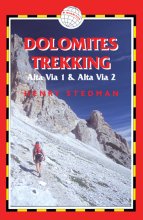Practical guidebooks for the more adventurous traveller.
— The Herald

Dolomites Trekking
Excerpt:
Route options and when to go
Contents | Introduction | Route options and when to go | With a group or independently? | Sample route guide | Minimum impact trekking

The Dolomites are criss-crossed by a huge and intricate network of trails. Some have proved to be more popular than others. In particular, there are the high routes, or alte vie (hohenweg in German). There are currently eight official alte vie, which, approximately at least, increase in difficulty the higher the number.
The first alta via was established in the late 1960s. The idea was to establish a high-level trail covering a variety of mountain groups and terrains. Alta Via 1 proved to be so popular that others followed soon after. Also described in this book, Alta Via 2 is the longest alta via of them all; and together the two trails are widely recognized as the finest of their kind.
Long treks
This book describes in detail two lengthy trails, each taking anything between ten days and three weeks to complete. The first trail, the Alta Via 1 (AV1) runs from north to south, starting at the Lago di Braies and finishing in the town of Belluno. The route runs through the eastern Dolomites and passes such renowned mountain peaks as Tofane, Pelmo and Schiara. The trek also passes near to the regional capital of Cortina d'Ampezzo. It is a beautiful trail that leads past some magnificent mountain scenery. By the standards of the region it is fairly undemanding, though there are a few exacting stretches here and there and the via ferrata at the end is three hours long and ocasionally quite demanding. There are, however, alternative paths allowing you to choose the level of difficulty of the trail on your trek.
The second trail described in this book, the Alta Via 2 (AV2) runs north to south all the way from Bressanone in the Val Pusteria to Feltre on the fringes of the Venetian plain. This route features spectacular views and passes over, round and between some of the Dolomites’ most dramatic mountains, including the region's highest peak, the Marmolada. In many ways it's slightly more demanding than the AV1, with more exposed trails and slightly more vie ferrate, though they're mostly simple enough and it doesn't have a stretch of via ferrata to compare with the last section of the AV1.
Short treks
For those who don't have the time, fitness or inclination to complete one of the longer trails, a number of short walks have also been devised which you'll find described (in less detail than the main walks) in Part 5. Remember, too, that both of the longer trails can be divided to make a series of shorter treks, and in Part 5 we suggest ways in which this can be done.
When to go
The Dolomites have a relatively brief trekking season that begins in mid-June and has all but finished by the end of September. It is possible to trek outside this period, in particular October, depending on the weather, though few of the rifugi will be open and the condition of the paths may be close to perilous.
Even during the trekking season the weather can be far from ideal and some of the routes may close if the path has become dangerously slippery or unstable. If you try to trek at the beginning of the season you also run the risk of trudging through some late-lying snow. July and August are better, though the latter can sometimes turn out to be a particularly soggy month with violent storms a common occurrence. This is also the most popular month – a little too popular for many trekkers’ tastes – when many Italians take to the mountains during their month-long holiday.
If I had to pick one month to go trekking in the Dolomites, I would not hesitate to choose September. The skies are often clear, the temperature is pleasantly mild and, best of all, the mountains and rifugi tend to be less busy. However, towards the end of the month (from about the 20th) many of the rifugi begin to close for the winter, so if you're trekking at this time make sure you ring ahead or ask in the local tourist office to find out which ones are still open.
Dolomites Trekking
Excerpts:
- Contents
- Introduction
- Route options and when to go
- With a group or independently?
- Sample route guide
- Minimum impact trekking
Latest tweets